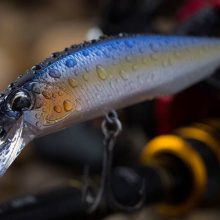This article may contain affiliate links. If you make a purchase after clicking on a link we may earn a small commission at no extra cost to you. As an Amazon Associate, I earn from qualifying purchases.
Suspending Jerkbaits for Bass – Tips and Tricks

Learning how to fish a suspending jerkbait for bass can greatly increase your chances of catching a lunker especially in colder months.
In warmer months most anglers will prefer a crankbait.
Despite popular opinion jerkbaits can also be used in warmer months but bass will be in shallower waters and will happily hit faster moving lures.
During the warmer you are better off using a floating jerkbait as a topwater lure choice.
However given the choice between crankbaits or jerkbaits the majority will stick to jerkbaits in colder water temperatures and crankbaits in the summer.
What are Suspending Jerkbaits?
Suspending jerkbaits are jerkbait lures that have a neutral buoyancy which allows them to stop or suspend at a certain depth once you stop retrieving them.
Like other jerkbaits the majority will come with a dive bill that helps get them down to a working depth.
A lure with a deep dive lip will be easier to get down deeper than one with a shallow lip.
Most of these lures will generally work only within a narrow range of depth. When retrieved you should be able to get them down to about 6 feet depending on the lure.
Some anglers will use a small split shot to help go deeper but this comes at a price as you will affect the swimming motion and they are technically no longer suspending lures.
One note to observe is that large swings in water temperature can seriously affect the buoyancy of any suspending lure as too can changing out the manufacturers treble hooks for after market ones.
Suspending Jerkbaits vs Floating Jerkbaits
Although the swim characteristics will be similar regardless of whether you are using a floating jerkbait or a suspending one, the real difference is what happens during the pause.
The suspending models will remain at roughly the same depth they were at just after you pause. With a floating jerkbait once you pause the lure will start to rise slowly towards the surface.
You can use the rise of the lure to great affect. Bounce it of a log or shallow rocky bottom and then allow it to rise.
This can be very effective for smallmouth bass when you are looking to work a jerkbait over the top of snags, with a floating lure you have less chance of getting snagged on the log or rocks.
Suspending Jerkbaits
The best suspending jerkbaits are designed to imitate a bait fish, the swim action and the twitch, twitch pause retrieval style mimics the start/stop pause of smaller fish and also of an injured bait fish.
Bass will routinely strike a suspended jerk baits as you pause in between the twitching movement that you impart on the lure with your rod tip.
This pause is what makes them particularly effect in colder months when water temperatures start to drop towards 40 degrees when bass tend to be at their most sluggish.
Bass are far less likely to strike a fast moving lure in the winter months.
A lot of anglers do not pause for long enough of a time to allow the bass to have a good look at the lure and then take a bite of it.
So just like your twitching motion when retrieving vary up how long you pause for too.
Water clarity also has a major effect on catching bass with a suspended jerkbait. The clearer the water the better especially in colder months.
There is no major vibration flash given off like when fishing a spinnerbait, instead bass need clear water to see your jerkbait and then have a chance to strike it.
Even during winter variances in temperature will affect how you fish a jerbait, and you may need to adapt your technique to this.
When the temperatures really drop another common tactic is to cast out the lure and do nothing once you get it down a few feet.
This is commonly referred to as dead sticking. You allow the jerkbait to stay suspended at a certain depth, when bass are super sluggish this can be a safe bet.
Keep a close eye on your line and don’t allow too much slack to build as you may miss a strike.
Tackle Considerations
When using suspending jerk baits you will be doing a lot of casting and putting action into the lure via the rod tip. This means that you need a rod that will transmit the energy from your wrist out to the lure without any loss of sensitivity.
The best rod for jerkbaits should have a medium power rating, a fast action and roughly be 6’6″ in length.
In very colder weather you may consider a rod with a medium/light power rating as it make your strike a little lighter and prevent ripping the hooks.
The best jerkbait line is flourocarbon for it’s low stretch characteristics and low visibility. Mono has far too mush stretch in it for this type of technique. If you do decide to use braid instead of flourocarbon fishing line then make sure to use a flourocarbon leader.
